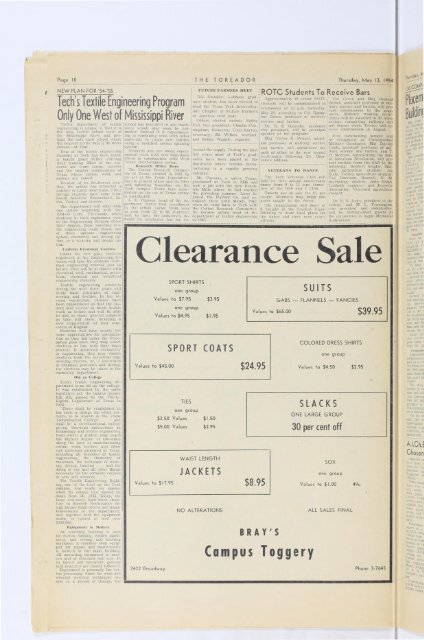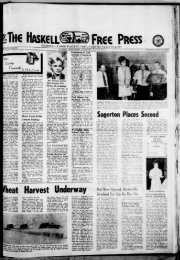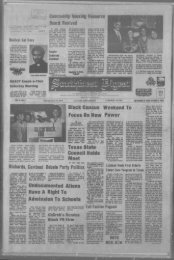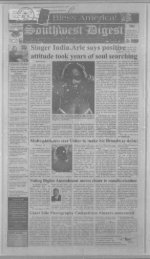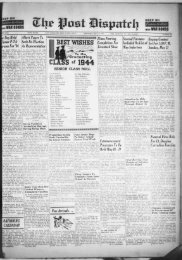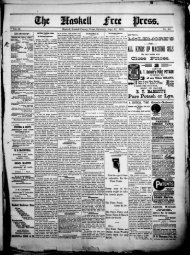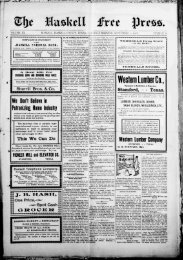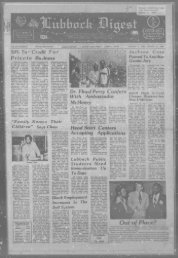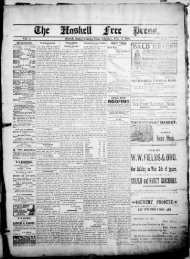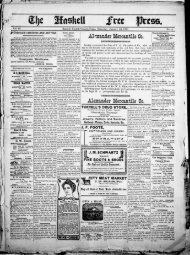The Toreador (1949-1956)_May 13, 1954.pdf
The Toreador (1949-1956)_May 13, 1954.pdf
The Toreador (1949-1956)_May 13, 1954.pdf
You also want an ePaper? Increase the reach of your titles
YUMPU automatically turns print PDFs into web optimized ePapers that Google loves.
1<br />
Page 10 THE TOREADOR Thursday, <strong>May</strong> <strong>13</strong>, 1954<br />
NEW PLAN FOR '54-'55<br />
Tech's Textile Engineering Program<br />
Only One West of Mississippi River<br />
Tech's department of textile<br />
engineering is unique in that it is<br />
the only textile school west of<br />
the Mississippi River and perhaps<br />
the only such school where<br />
the nearest textile mill is 40 miles<br />
distant—at Post.<br />
Few of the textile engineering<br />
students at Tech had been inside<br />
a textile plant before starting<br />
their training. Most of the students<br />
are from farms, ranches<br />
and the smaller communities of<br />
Texas where cotton, wool, and<br />
mohair are raised.<br />
Because of its Southwest location,<br />
the school has attracted a<br />
number of Latin Americans. Other<br />
foreign students have come from<br />
South America, Switzerland, India,<br />
Turkey and Greece.<br />
<strong>The</strong> department will offer only<br />
one option beginning with the<br />
1954-55 term. Previously, when<br />
students in their sophomore year<br />
in the Engineering Division chose<br />
their majors, those selecting tex -<br />
tile engineering could choose one<br />
of three options — engineering<br />
option, chemistry and dyeing option,<br />
or a weaving and design option.<br />
Uniform Freshman Courses<br />
Under the new plan, students<br />
registered in the Engineering, Division<br />
will take Use uniform ireshman<br />
engineering courses just as<br />
before. <strong>The</strong>y will be in classes with<br />
electrical, civil, mechanical, petroleum,<br />
chemical and industrial<br />
engineering students.<br />
Textile engineering students<br />
during the next three years will<br />
study basic principles of engineering<br />
and textiles. In the revised<br />
curriculum, courses have<br />
been consolidated so that the student<br />
will receive as much textile<br />
work as before, and will be able<br />
to add as many general subjects<br />
as time will allow, including a<br />
new requirement of four semesters<br />
of English.<br />
Students will have nearly the<br />
same opportunities for specialization<br />
as they did under the threeoption<br />
plan since they may select<br />
electives in line with their main<br />
interest. If interested exclusively<br />
in engineering, they may choose<br />
electives from the industrial engineering<br />
courses, or, if interested<br />
in chemical processes and dyeing,<br />
the electives may be taken in the<br />
chemistry department.<br />
Old as College<br />
Tech's textile engineering department<br />
ias old as the college.<br />
It was established by the same<br />
legislative act, the famous Senate<br />
Bill 103, passed by the Thirty-<br />
Eighth Legislature of Texas in<br />
1923:<br />
"<strong>The</strong>re shall be established in<br />
the state a college for white students,<br />
to be known as the Texas<br />
Technological College . . and<br />
shall be a co-educational college<br />
giving thorough instructions in<br />
technology and textile engineering<br />
from which a student may reach<br />
the highest degree of education<br />
along the lines of manufacturing<br />
cotton, wool, leather, and other<br />
raw materials produced in Texas,<br />
including all branches of textile<br />
engineering,. the chemistry of<br />
materials, the technique of weaving,<br />
dyeing, tanning . . . and the<br />
doing of any and all other things<br />
necessary for the complete courses<br />
in arts and sciences . . ."<br />
<strong>The</strong> Textile Engineering Building,<br />
one of the first on the Tech<br />
campus, was ready for classes<br />
when the college first opened its<br />
doors Sept. 20, 1925. Today, the<br />
large two-story, light brick structure<br />
in Spanish Renaissance design<br />
houses main offices and major<br />
laboratories of the department;<br />
and, together with the equipment<br />
inside, is valued at well over<br />
$500,000.<br />
Equipment is Modern<br />
An auxiliary building is used<br />
for cotton classing, woolen machinery,<br />
and sewing and knitting<br />
machines. A machine shop equipped<br />
for repair and maintenance<br />
is located in the main building.<br />
All operating equipment is modern<br />
and of standard mill size. In<br />
its layout and operation, general<br />
mill practices are closely followed.<br />
Equipment is primarily for cotton<br />
processing. Since the wool and<br />
worsted weaving techniques are<br />
now in a period of change, the<br />
school has hesitated to add machinery<br />
which may soon, be outmoded.<br />
Instead it is experimenting<br />
in combining wool with other<br />
materials to create new fabrics,<br />
using a modified cotton spinning<br />
system.<br />
Students also are doing experimental<br />
work with new man-made<br />
fibers in combination with West<br />
Texas' short-stapled cotton.<br />
Research Office Here<br />
<strong>The</strong> Cotton Research Committee<br />
of Texas, created in 1941 by<br />
an act of the Texas Legislature,<br />
has its general ofices and its fiber<br />
and tsplinrting branches on the<br />
Tech campus. From here information<br />
on the use of Texas cotton<br />
is distributed.<br />
L. E. Parsons. head of the department,<br />
states that enrollment<br />
in the school varies from year<br />
to year from 25 to 60 students;<br />
and, to date, the .industry's demand<br />
for graduates has far ex-<br />
Clearance Sale<br />
SPORT SHIRTS<br />
one group<br />
Values to $7.95<br />
one group<br />
Values to $4.95<br />
SPORT COATS<br />
Values to $45.00 $24.95<br />
TIES<br />
one group<br />
$3.95<br />
$1.95<br />
$2.50 Values $1.50<br />
$5.00 Values $2.95<br />
FUTURE FARMERS MEET<br />
Bill Standlee, Lubbock graduate<br />
student, has been elected to<br />
head the Texas Tech Intercollegiate<br />
Chapter of Future Farmers<br />
of America next year.<br />
Others elected include Bobby<br />
Pell, vice president; Charles Cunningham,<br />
treasurer; Cecil Barton,<br />
secretary; Ed Wilkes, sentinel;<br />
and Bobby Waddle, reporter.<br />
ceeded the supply. During the past<br />
few years most of Tech's graduates<br />
have been placed in the<br />
Southwest where textiles manufacturing<br />
is a rapidly growing<br />
industry.<br />
Mr. Parsons, a native Texan,<br />
graduated at Tech in 1936 and<br />
took a job with the new Braunfels<br />
Mills where he had worked<br />
the preceding summer. Later he<br />
joined the DuPont Co. and remained<br />
there until March, 1942,<br />
when he came back to Tech with<br />
the Cotton Research Committee.<br />
He became acting head of the<br />
department of textile engineering<br />
in 1945<br />
WAIST LENGTH<br />
JACKETS<br />
Values to $17.95 $8.95<br />
ROTC Students To<br />
Approximately 18 senior ROTC<br />
students will be commissioned in<br />
ceremonies at 10 a.m. Saturday,<br />
<strong>May</strong> 29, according to Col. Hampton<br />
Green, professor of military<br />
science and tactics.<br />
Dr. G. E. Giesecke, academic<br />
vice president, will be principal<br />
speaker at the program.<br />
Maj. Victor B. Penuel, assistant<br />
professor of military science<br />
and tactics. will administer the<br />
oath of office to the new second<br />
lieutenants following Dr. Giesecke's<br />
address,<br />
VETERANS TO DANCE<br />
<strong>The</strong> Tech Veterans Club will<br />
hold its first annual anniversary<br />
dance from 8 to 11 pm. tomorrow<br />
at the 16th and J Club.<br />
Tickets are on sale for $1 per<br />
couple. Members may bring one<br />
guest couple to the event.<br />
<strong>The</strong> organization will meet at<br />
8 tonight in the Student Union<br />
Bhilding to draw final plans for<br />
the dance and elect next year's<br />
officers.<br />
COLORED DRESS SHIRTS<br />
one group<br />
Values to $4.50 $2.95<br />
SLACKS<br />
ONE LARGE GROUP<br />
30 per cent off<br />
SOX<br />
one group<br />
Values to $1.00 4 9 c<br />
NO ALTERATIONS ALL SALES FINAL<br />
BRAY'S<br />
Campus Toggery<br />
SUITS<br />
GABS — FLANNELS — FANCIES<br />
Receive Bars<br />
Col. Gretdi and Maj. Richard<br />
Brown, assistant professor of military<br />
science and tactics, will present<br />
commissions to the graduates.<br />
Military training certificates<br />
will be awarded to 37 other<br />
seniors completing military but<br />
not degree work. Twelve will receive<br />
commissions in August.<br />
Five outstanding seniors will<br />
be recognized as Distinguished<br />
Military Graduates. Maj. Dayton<br />
Caple, assistant professor of military<br />
science and tactics, and T.<br />
H. Morrow, representing the Sons<br />
of American Revolution, will present<br />
medals from the SAR to the<br />
following: Herbert Seigler, Matador<br />
agriculture student; Jay<br />
Eudy, Turkey agriculture student;<br />
Ted Harrison, Roswell, N. M.<br />
psychology student; John Nolan,<br />
Lubbock engineer; and Everette<br />
Abernathie, Vineyard agriculture<br />
student.<br />
Dr. E. N. Jones, president of the<br />
college, and M. L. Pennington,<br />
vice president and comptroller,<br />
will be distinguished guests at<br />
the ceremonies in Aggie Memorial<br />
A1,111nrium.<br />
Values to $65.00 $39.95<br />
2422 Broadway Phone 3-7643<br />
j v<br />
ihurs<br />
Placer<br />
guildin<br />
do, N* sif:v: i:: 1:1Po gj.thTh pan :,:r;s1: 1:itr l<br />
iitas ms:::: ,<br />
nng<br />
oo ter,<br />
t hasrn?L9,ganh d<br />
and<br />
Iy<br />
students Psoa odirrtut.i.r'<br />
said. 10 194 1<br />
down :p er ittnirn' rledns .' i'j e' ste, meo: e P<br />
th call<br />
is tfiltatih ana rs rla i irk s.i 1: 1 eot'ete<br />
6l<br />
industrial<br />
;th<br />
y.d sal nopupnide<br />
first rsiteoni f e,<br />
most<br />
for a t4.,0 h<br />
Jo,<br />
Presen t<br />
anrgr e s ri onf offerer<br />
gradua tte es s st<br />
dill Way at<br />
Several tf<br />
this shOrta Ee<br />
gigantic te<br />
ith<br />
hr o<br />
d 0birth f medr<br />
sion; and en t<br />
around °them'<br />
About <strong>13</strong>0<br />
tilar inteni<br />
reae, some e:<br />
trips for d5I<br />
ACpPromPsili I<br />
part mvedi y inmin ternasdizi' te,1<br />
sameirms<br />
last year's Cl;<br />
sealed.<br />
<strong>The</strong><br />
Se Senior sistoren<br />
ness and ad<br />
dies. Caterin g<br />
does not im f<br />
Nortn-antechn e iochl<br />
ed 0toe this th, me oc<br />
sa<br />
opportunities<br />
e' bar' ieilgting a n ruore5<strong>13</strong>nAh 711<br />
A61.0sC<br />
Chosen<br />
at, at,<br />
wrist<br />
addition<br />
water muo<br />
.1Th 00c<br />
E0. 1,pa tincpad::: I<br />
senior<br />
?rind<br />
I ro,p,ius hict Disti ll<br />
Sleutatirdin .anftiAng<br />
Laic gw:,r,<br />
\Vida t<br />
u,r. A. G.<br />
; and<br />
i<br />
al


